The Museum Collections
Introduction
I. History and Art Collection
1. Icons of the 14th – 19th centuries
icons of the 14th – 17th century
2. Jewelry art of the 14th – 20th century
jewelry art of the 14th – 17th century
jewelry art of the 18th – 19th century
the european silver 14th - 19th centuries
3. Small-size sculptures (works of metal, wood, bone)
XI – the beginning of the XX century
Small-size sculptures 11th – 17th century
Small-size sculptures 18th – early 20th century
enamel of Troitza masters 15-8th – early 20th century
5.Embroidery, lace, textiles of the 14th - early 20th century
icon and ornamental embroidery
gold and silver lace
6.Painting of the 18th – 21st centuries
painting of the 18th – 19th centuris
painting of the 20th – 21st centuris
II.Manuscripts and old printed books of the 14th – 17th century
IV.Lithography of the 18th – 19th century
V.Numismatics
VI.Medals of the 18th - early 20th century
VIII.Archeology collection
IX. Russian folk and applied and decorative art of the 17th – 21st c.
1. Artistic wood
folk carved and painted wood
wooden toys
house carving of Sergiev Posad
Khokhloma and Gorodets painting
2. Artistic textiles
embroidery and weaving
printed textiles and lace
Russian shawls
folk costumes
folk garments
printed cotton kerchiefs
|
Jewelry Art of the 14th – 17th cc. (page 2)
|
Russian silversmiths frequently used architectural models for their works. The earliest item of this type in the Museum collection is the censer, made, according to the inscription, “to the conception” of Hegumen Nikon in 1405. In the 15th century, complicated filigree flourished in Moscow. It was widely used in decoration of icon mountings, books, church vessels.
The gold chalice made by Ivan Fomin and donated to the Monastery by Grand Prince Vassili II in 1449. The gold setting of the carved wall-nut icon proofs the flowering of filigree in the 15th century. It was made in 1456 by Ambrose, a talented carver and skilful goldsmith
The silver gilded dippers strike with exceptional beauty. Very few boatshaped dippers have survived. The earliest Russian dippers refer to the 15th century. They originated in Novgorod. However, ancient Moscow dippers do not differ greatly from Novgorod samples, which is proved by the dipper of boyar Pyotr Mikhailovich Pleshcheyev.
|
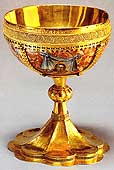
Chalice. 1449. Work of Ivan Fomin. Donated by Grand Prince Vassili II. |
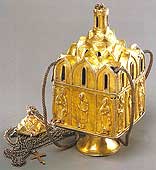
Censer. 1405. Belonged to Father Superior Nikon |
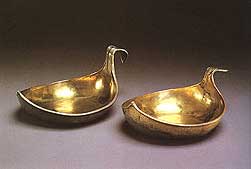
Dippers. 15th century.
Belonged to Grigory Posakhno and Pyotr Pleshcheyev
|
Silver secular and church utensils of the 16th century are richly represented in the Museum collection. Many of them are connected with concrete historical figures, as recorded in the Monastery Donation Books or in the occasional ligature inscriptions, decorating the items themselves.
Òhe original chandelier of 1568 shaped like a silver sphere with four candlesticks in the form of gold snakes with a massive truss of twisted gold threads was donated by Tsar Ivan the Terrible. In 1564, Ivan the Terrible donated the large toasting cup in memory of his uncle Prince Vassili Mikhailovich Glinsky. The fine dipper of Princess Kilikia Ushataya bears a poetical on the rim: “This is a dipper to drink for health, praying to God, praising the Tsar, remembering the beloved fread”.
|

Chandelier. 1568. Donated by Tsar Ivan the Terrible |
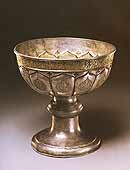
Toasting Cup. 1564. Donated by Tsar Ivan the Terrible |
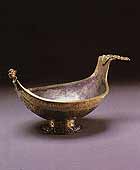
Dipper. 16th century. Donated by Princess Kilikia Ushataya
|
Loving cups of the 16th century from the Museum collection are referred to the earliest group in our country. Bowls and low cups with flat bottoms are ancient Russian drinking vessels. They are noted for their sizes and sometimes for flat handles-ledges. All surviving cups are not dated back earlier then the 16th century.
The Museum preserves rare loving cups of the 16th century which originally belonged to the Monastery Cellarer Eustathius Golovkin and Marfa Vladimirovna, the daughter of Prince Vladimir Andreyevich Staritsky. There are also various vessels including the bowl with the name of Tsarevich Feodor Ivanovich and cup of the Tsar groom Pyotr Nikitich Nikiforov with Samson tearing the lion’s mouth chased on the handle. All items are remarkable for their rational shapes and harmonious
decoration.
|
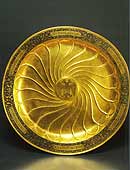
Dish.Workshops of the Moscow Kremlin.1561. Donated by Tsar Ivan the Terrible |
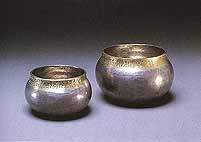
Loving cups. 16th century. Belonged to Eustathius Golovkin and Marfa Staritskaya |
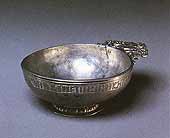
Bowl. 16th century. Belonged to Tsarevich Feodor Ivanovich |
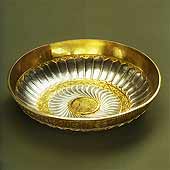
Cup. 16th century. Belonged to Pyotr Nikitich Nikiforov
|
The 16th century is a recognized heyday of Russian jewelry art. Moscow craftsmen took the leading place in the development and refinement of the ancient techniques: engraving and niello, filigree, chasing, enamel. The techniques acquired new qualities when they were combined in decoration of articles. Among of the best works of Moscow goldsmiths of the second half of the 16th century are fragments of the mounting for “The Old Testament Trinity” icon, donated by Ivan the Terrible, - the crowns, crescent collars with pendants, plaques with niello, small fragments of the chased plaques from the margins and from the background. Every detail of the mounting demonstrates the great skill. The crowns decoration is based on the effect of combination of glittering patterns and matted background. Thus the qualities of the precious metal are emphasized.
The mounting of the triptych, depicting the Petrovskaya Virgin and Metropolitans Peter and Alexius, is an interesting specimen of Novgorod filigree.
|
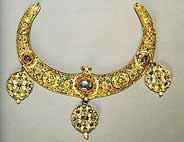
Crescent collar. Mid-16th century. Detail of the mounting for the icon “The Old Testament Trinity”. Donated by Tsar Ivan the Terrible |

Crown. Mid-16th century. Detail of the mounting for the icon “The Old Testament Trinity”. Donated by Tsar Ivan the Terribler |
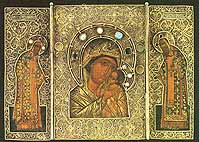
The Petrovskaya Virgin with Metropolitans Peter and Alexius. Triptych. Second half of the 16th century. Novgorod
|
|


